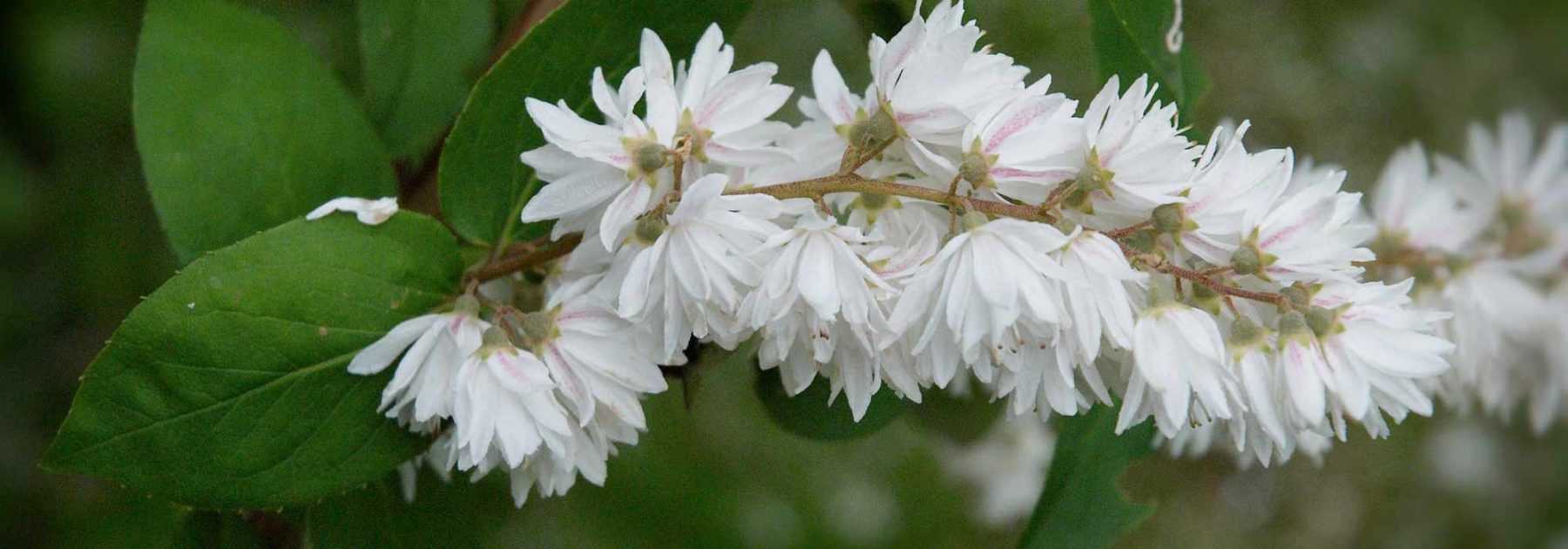
Deutzia: Planting, Pruning and Care
Contents
The Deutzia in a nutshell
- Deutzia is an easy-to-grow shrub, perfect even for novice gardeners
- With its white or pink flowers, its spring blooming is spectacular!
- Highly hardy and disease-resistant, it thrives in any good garden soil that remains moist
- It grows quickly but doesn’t become too large, making it ideal for small gardens
- Versatile, it’s a classic choice for hedges, and can also be used in borders, as a standalone feature or in pots
Our expert's word
The Deutzia or Deutzie is a beautiful spring-flowering shrub, much loved for its endless airy blooms, compact size, and exceptional ease of cultivation. Somewhat out of fashion, the deutzia is one of those nearly indestructible shrubs, undemanding and effortlessly rewarding for gardeners, even beginners.
In late spring, it becomes covered in a cloud of small white or pink flowers, like the Deutzia crenata ‘Pride of Rochester’, the pink Deutzia, scabra ‘Plena’, or the Deutzia (x) magnifica ‘Tourbillon Rouge’.
A reasonably sized shrub, the Deutzia is a reliable choice, essential in every garden, even small ones, whether in informal hedges or mixed borders. The smallest varieties, such as Deutzia gracilis ‘Nikko’, which won’t exceed 1m in height at maturity, can be used as ground cover on a sunny slope or planted in a container on the terrace.
Highly hardy, cold and frost-resistant, the Deutzia is adaptable to any fresh soil, even poor, acidic, or chalky, in partial shade or full sun—though it flowers best in rich, well-drained soil.
From pruning to planting, explore our collection of deutzias, including some rare and exclusive varieties, and discover this easy-to-grow shrub, perfect for brightening up a shady spot in the garden.
Description and Botany
Botanical data
- Latin name Deutzia
- Family Hydrangeaceae
- Common name Deutzia
- Flowering May to July
- Height 0.50 to 3 m
- Exposure Sun, partial shade
- Soil type All types, well-drained
- Hardiness -20°C
The Deutzia belongs to the Hydrangeaceae family (formerly Saxifragaceae), just like hydrangeas. Native to eastern Asia, this deciduous shrub grows naturally in thickets and wooded areas of the Himalayas.
The Deutzia genus includes around sixty species, with the most common being Deutzia gracilis, Deutzia x magnifica, Deutzia scabra, and Deutzia purpurascens, which have given rise to numerous hybrids like Deutzia (x) elegantissima and interesting cultivars such as ‘Nikko’, one of the best Deutzia cultivars.
With relatively fast growth, it reaches its mature size in 5 to 7 years, not exceeding a height of 3 m and a spread of 2 m for the larger Deutzia varieties. Some very recent hybrid varieties (Yuki) form a dome that won’t exceed 60 cm in any direction and have the ability to self-layer, eventually forming a large ground cover.
The Deutzia forms a small, upright bush, more or less compact due to its branching foliage. The habit is vigorous and rounded, becoming more erect if left unpruned. The slender, somewhat drooping branches at the tips become arched over time.
In spring, oval or lance-shaped, tapered leaves, often slightly serrated at the edges, appear on long, straight, cane-like stems. Medium to dark green on top, 2 to 12 cm long, sometimes heavily veined, they often have a grey-green, hairy underside, even rough in the case of Deutzia scabra (which means “rough” in Latin). Depending on the variety, they turn bronze and purple-violet by the end of the season.
Some, like Deutzia scabra, remain very decorative even after leaf fall with their beautiful cinnamon-brown bark that exfoliates when mature.
Its spring flowering is enchanting! In early summer, from May to July depending on the climate, this fresh green foliage disappears under a cascade of small flowers in very romantic shades. A spectacular bloom resembling a delicate cloud, when pure white, Deutzia is also nicknamed “Snow of Spring”. Infinitely delicate, these continuously produced corollas come in all shades of white, pink, sometimes purple-mauve or lavender blue.
Gathered in rounded clusters, upright racemes, or large, airy panicles 2 to 15 cm long, these small, 5-petalled flowers, cup-shaped or star-like, bloom for 4 weeks. Single or double, they are 0.50 to 3 cm wide. These delicate corolles evoke lilac flowers, lily-of-the-valley bells, Kalmias, or even cherry blossoms.
Some, like ‘Tourbillon Rouge’ or ‘Plena’, are remarkable for their striped petals, giving the blooms a two-toned, luminous appearance. Depending on the variety, they fade to a lighter shade as they mature.
These flower stems hold up well in vases for fresh bouquets.
Often fragrant, they attract pollinating insects.


Flowers: Deutzia scabra ‘Plena’ / Deutzia rosea ‘Campanulata’ / Deutzia purpurascens ‘Kalmiiflora’ / Deutzia crenata ‘Pride of Rochester’ / Deutzia purpurascens ‘Kalmiiflora’
While it tolerates ordinary soil, even chalky ground, to flower well the Deutzia prefers rich, deep, well-drained and moist soils. Hardy down to -20°C, it’s best planted sheltered from cold, harsh winds to protect its beautiful blooms, in partial shade, though it tolerates full sun if not scorching. It will adapt to dry gardens with good mulching.
It can be used as a standalone in a small garden or in a free-flowering or mixed hedge in all garden styles, whether English, cottage, or simply romantic and wild.


Foliage: Deutzia scabra ‘Variegata’ / Deutzia gracilis ‘Nikko’ / Deutzia ‘Strawberry Field’ / Deutzia scabra ‘Codsall Pink’ / Deutzia compacta ‘Lavender Time’.
Main species and varieties
The Deutzia genus includes around sixty species, the most common being Deutzia gracilis, Deutzia crenata, Deutzia × magnifica, Deutzia scabra, Deutzia purpurascens, and Deutzia rosea. These have given rise to many more vigorous and floriferous hybrids (Deutzia × elegantissima, Deutzia hybrida) as well as interesting dwarf cultivars such as Deutzia ‘Yuki Cherry Blossom’ and Deutzia gracilis ‘Nikko’, perfect for small spaces or balcony displays. Upright varieties like ‘Pride of Rochester’ are classic choices for flowering hedges.
Their blooms range from white to deep pink, depending on the variety.
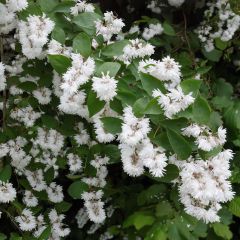
Deutzia crenata Pride of Rochester
- Flowering time June, July
- Height at maturity 2,75 m
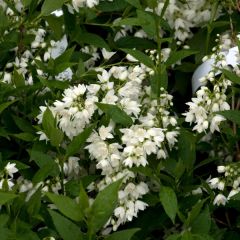
Deutzia gracilis
- Flowering time June, July
- Height at maturity 1 m
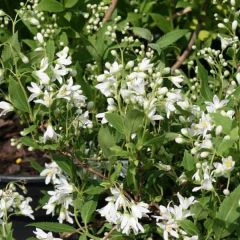
Deutzia gracilis Nikko
- Flowering time June, July
- Height at maturity 50 cm
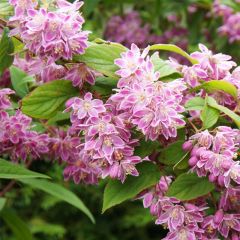
Deutzia Tourbillon Rouge
- Flowering time July, August
- Height at maturity 1,75 m
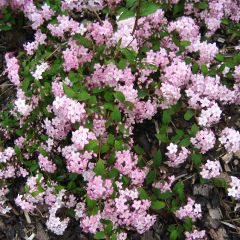
Deutzia elegantissima Rosealind
- Flowering time June, July
- Height at maturity 1,50 m

Deutzia scabra Plena
- Flowering time July, August
- Height at maturity 2,50 m
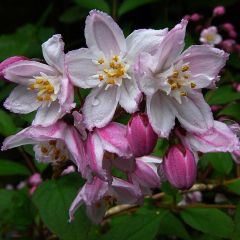
Deutzia purpurascens Kalmiiflora
- Flowering time June, July
- Height at maturity 1,50 m
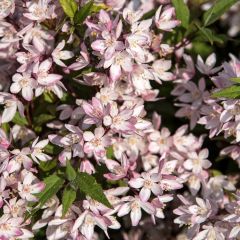
Deutzia Yuki Cherry Blossom
- Flowering time June to August
- Height at maturity 50 cm

Deutzia setchuenensis Corymbiflora
- Flowering time July to November
- Height at maturity 90 cm
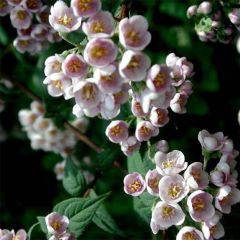
Deutzia compacta Lavender Time
- Flowering time July, August
- Height at maturity 1,20 m
Discover other Deutzia
Planting
Where to Plant Deutzia
Very hardy, the deutzia is not afraid of cold, it can withstand temperatures as low as -15 to -20°C, but fears icy winds which may compromise flowering by destroying some flower buds: planting in a sheltered spot away from cold draughts is essential.
This shrub can be grown almost anywhere in France. South of the Loire, it will tolerate occasionally dry soil with good mulching but will dislike scorching sun; grow it in a shaded corner of the garden, protected from direct sunlight where it will enjoy a few hours of morning or late afternoon sun.
Elsewhere, it will thrive in full sun. Avoid deep shade, as it needs light to flower well.
Undemanding, it is happy with ordinary soil, even chalky or acidic, but will flower more profusely in fresh, well-drained and rich soil. It dislikes overly dry soil in summer and fears compacted, waterlogged soil in winter: avoid waterlogged areas.
Choose a location that accommodates the largest deutzias, which can reach 1.80 × 1 m in 3 years—they need space to grow freely. Though fast-growing, it won’t exceed 3 m in height at maturity, making it a great choice for small gardens.
Deutzia is highly versatile in the garden. It displays a lush mass entirely covered in a cloud of white or pink flowers, making it indispensable in a free-flowering or mixed hedge with other spring-flowering shrubs or staggered bloomers. Very adaptable, this beautiful shrub also works well to fill out a cottage-style border, alongside perennials or in a sunny rockery. It can also fill gaps in tree plantings. With its elegant shape, it also shines as a standalone feature in a small garden and even in a large pot.
In larger gardens, it looks stunning planted in groups of three or five.
Plant vigorous deutzias like ‘Pride Of Rochester’ in a sheltered spot for a flowering hedge, while semi-prostrate varieties like Deutzia gracilis ‘Nikko’ or Deutzia x rosea are perfect planted en masse on a sunny bank, in a rockery, along borders or paths, either alone or mixed with other small ground-cover shrubs.
When to Plant?
Potted Deutzia can be planted year-round, avoiding frost and drought periods. Ideally, for best establishment, plant in autumn, from September to November in warm regions, or preferably in spring (March–April) elsewhere.
How to Plant?
In the ground
For hedges, space plants 60 cm to 1 m apart.
- Soak the rootball in a bucket of water overnight before planting
- Loosen the soil well
- Dig a hole at least three times wider than the rootball and 50 cm deep
- Backfill with excavated soil mixed with two buckets of compost, keeping the shrub upright and the root collar slightly below soil level
- Firm the soil, creating a shallow basin around the base
- Apply a 10 cm-thick organic mulch (e.g., pine bark), especially in warm regions
- Water thoroughly with two watering cans after planting
Growing Deutzia in pots
Choose dwarf varieties like Deutzia gracilis ‘Nikko’.
- Use a fresh, well-draining mix of shrub compost blended with well-rotted manure or compost
- Select a large container (minimum 30 litres, 30–40 cm diameter) and add a layer of gravel or clay pebbles at the base
- Mulch the base
- Water regularly during growth and when the soil dries out
Care and Maintenance
A well-established deutzia requires little care.
Deutzias dislike dry soils in summer, they must never lack water. Nevertheless, they adapt to dry gardens with good mulching. Spread a thick layer of organic mulch (pine bark or needles, leaf litter), renewed each year, to keep the roots cool during summer heat.
Water regularly but moderately, every three to four days, especially during the first 2 or 3 summers.
For potted deutzias, water as soon as the soil dries out, as their needs are greater than when planted in the ground.
Hardy, deutzias are not prone to diseases.
Pruning Deutzia: When and How to Prune a Deutzia?
The Deutzia requires light annual or biennial maintenance pruning, immediately after flowering. Pruning helps to thin out the branches, maintain a nice bushy shape, encourage new growth and ensure abundant and regular flowering.
- Trim spent flower stems by cutting them back by one third, just above an outward-facing bud
- Remove dead branches
- To rejuvenate an older plant every 4 or 5 years, prune more severely at ground level, removing old wood, dead stems, weak or tangled growth to allow light to penetrate the centre of the shrub – it will only flower again two years later
→ More Deutzia pruning advice in our guide.
Taking Cuttings from Deutzia
The deutzia propagates quite easily from stem cuttings.
From semi-hardwood cuttings
- After flowering, in August, take semi-hardwood cuttings (transitioning from softwood to hardwood) of 10-20 cm, cutting 1 cm below a bud for the lower part
- Remove the lower leaves
- Plant them in pots, burying two-thirds of their length, leaving only the top bud exposed in a light, well-draining growing medium
- Mist the cuttings regularly – they root quickly
- Plant out in autumn if root development is sufficient, or the following spring
From softwood cuttings
- In June, cut a stem below a leaf or bud
- Remove the lower leaves
- Plant in pots or trays in a mix of garden soil, compost and river sand
- Keep the cuttings moist and sheltered until rooted
- Transplant them in autumn when the root system is sufficiently developed
→ Learn more about propagating deutzia in our advice sheet!
Ideas for plant combinations
With its abundant flowering, the Deutzia will always add a striking floral touch to the garden. It works equally well as a standalone feature, in a large pot, or in a cottage-style border, a sunny rockery, or alongside perennial plants. As it tolerates partial shade well, it is invaluable for bringing a refined and luminous touch to the darker corners of the garden.
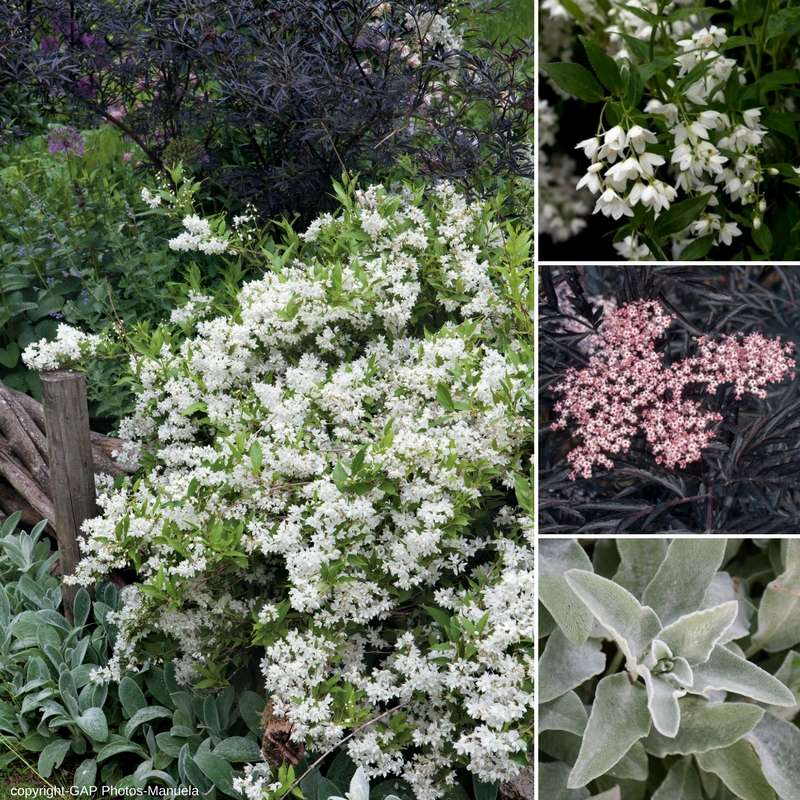

An example of a cottage-style association: Deutzia gracilis, Sambucus nigra ‘Black Lace’, Stachys byzantina.
It will integrate beautifully in pastel tones or to add contrast, in an English cottage garden, a traditional parsonage garden, or simply a romantic and wild garden. Typically flowering during the rose season, in late spring and early summer, it makes an exceptional companion in an all-white garden alongside old-fashioned roses, ornamental tobacco plants, and late-flowering white tulip bulbs, creating charming and romantic scenes.
In a mixed hedge, it can be combined with other flowering shrubs such as Kolkwitzia, weigelas, Abelias, laburnums, or brooms.
Alternate them with mock oranges or lilacs for a fully flowering hedge, or with evergreen shrubs for year-round interest, such as barberries, cotoneasters, an eleagnus, an Osmanthus x burkwoodii, or a Mexican orange blossom ‘Apple Blossom’.


An example of a four-season hedge association: Osmanthus x burkwoodii, Berberis thunbergii, Eleagnus ‘Quicksilver’, Deutzia scabra ‘Plena’, Cotoneaster lacteus.
For a more contrasting effect, pair it with the blue flowers of agapanthus, columbines, bellflowers, the magenta pink of a valerian, or the crimson of a foxglove.
It harmonises beautifully with almost all other colours, and the larger deutzias can support a late-flowering clematis.
Dwarf varieties (Deutzia ‘Yuki Cherry Blossom’) make excellent ground cover on a sunny slope, either alone or mixed with other small shrubs such as spireas ‘Anthony Waterer’, dwarf weigelas, ground-cover roses like ‘The Fairy’, or perennials such as hardy geraniums.
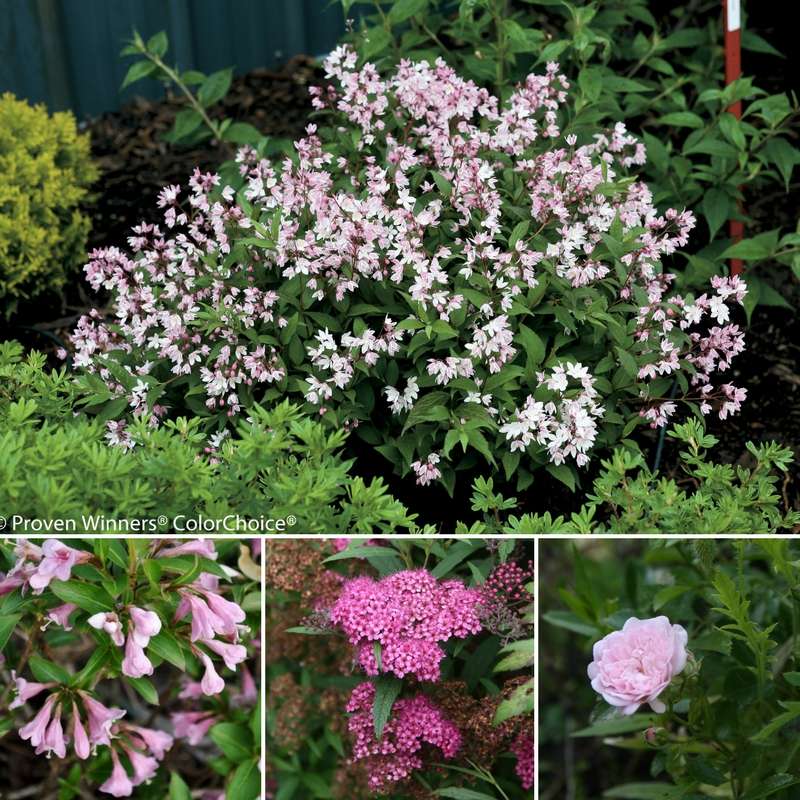

An example of an association on a slope: Deutzia ‘Yuki Cherry Blossom’, Weigela florida ‘Pink Poppet’, Spiraea japonica ‘Anthony Waterer’, Rosa ‘The Fairy’.
Useful resources
- The most beautiful spring-flowering shrubs are here!
- Advice sheet: Deutzias – 5 planting companions
- Advice sheet: Deutzia – when and how to prune?
- Advice sheet: Growing Deutzia in pots
- Advice sheet: Choosing a Deutzia
- Our advice sheets: 7 pink-flowered Deutzias, 6 white-flowered Deutzias
- Discover our selection of 6 perfect Deutzias for a flowering hedge
- Subscribe!
- Contents


































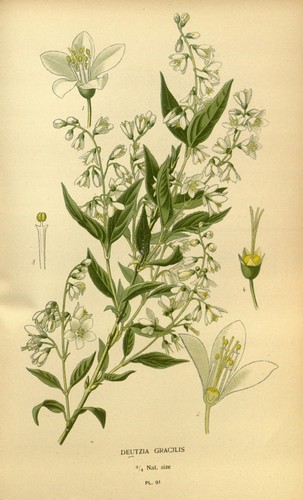



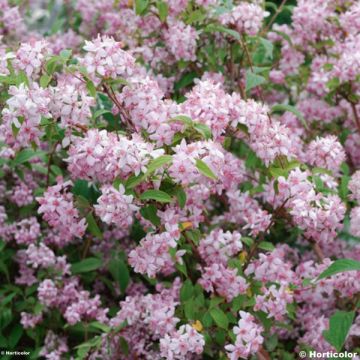
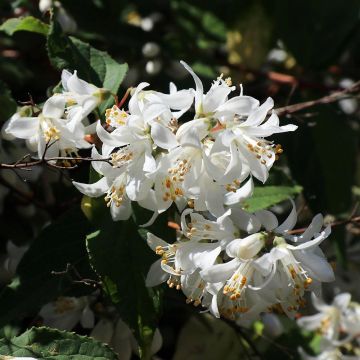
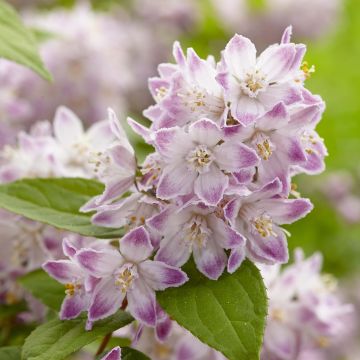

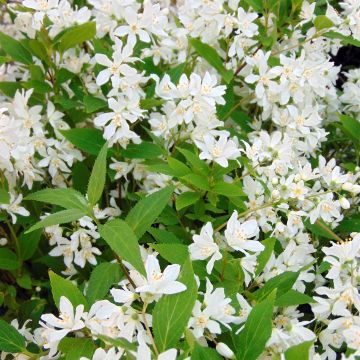

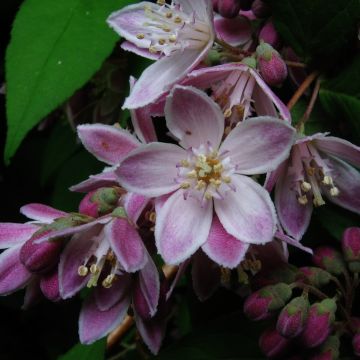

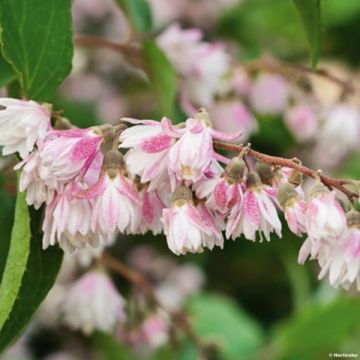


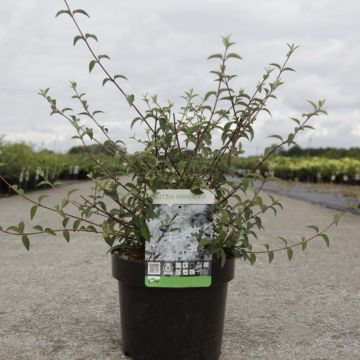
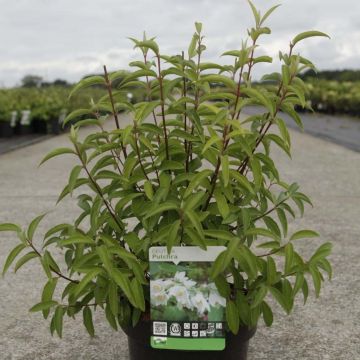
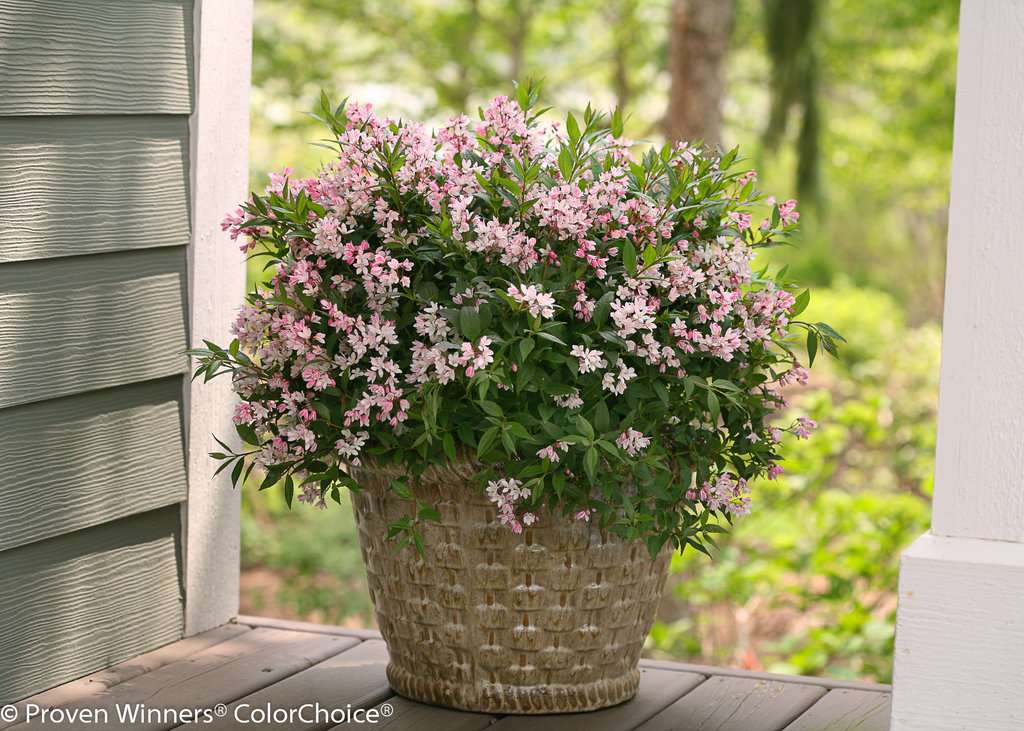
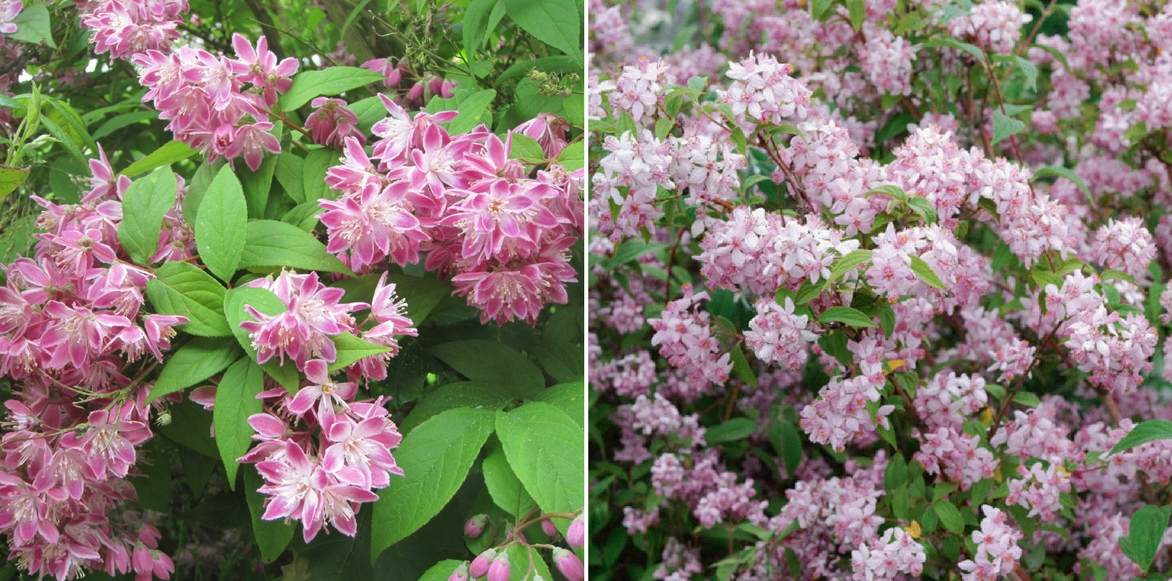
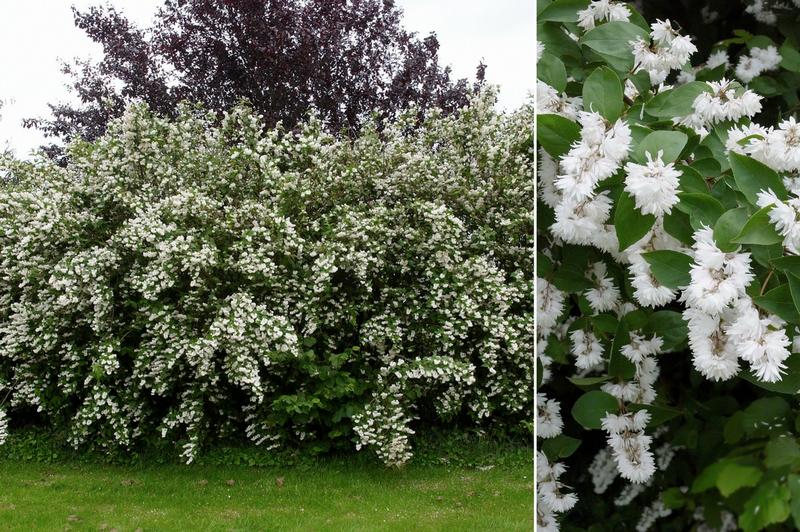
Comments